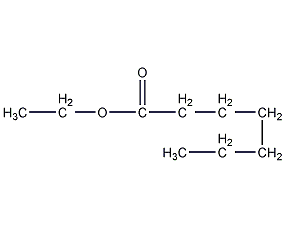
Structural formula
| Business number | 02T2 |
|---|---|
| Molecular formula | C9H18O2 |
| Molecular weight | 158.24 |
| label |
Ethyl enanthate, Ethyl paraselate, cognac oil, grape seed oil, Ethyl n-heptanoate, Artificial Conic Oil, Ethyl oenanthate, Ethyl n-heptanoate, Ethyl heptanoate, Ethyl heptoate, Ethyl heptylate, Ethyl enanthate, Enanthic acid ethyl ester, Heptanoic acid ethyl ester, Flavors and fragrances |
Numbering system
CAS number:106-30-9
MDL number:MFCD00009538
EINECS number:203-382-9
RTECS number:MJ2087000
BRN number:1752311
PubChem ID:None
Physical property data
1. Properties: Colorless transparent liquid
2. Density (g/mL, 25℃): 0.87
3. Relative density (25℃, 4℃): 0.8630
4. Melting point (ºC): -56.1
5. Boiling point (ºC, normal pressure): 188.6
6. Boiling point (ºC, 46.6kpa ): 95
7. Refractive index: 1.4129
8. Flash point (ºC): 66
9. Refractive index at room temperature (n25 ): 1.4109
10. Autoignition point or ignition temperature (ºC): Not determined
11. Vapor pressure (mmHg, 20ºC): Not determined
12. Saturated vapor pressure (kPa, ºC): Undetermined
13. Heat of combustion (KJ/mol): Undetermined
14. Critical temperature (ºC) : 360.85
15. Critical pressure (KPa): Undetermined
16. Log value of oil-water (octanol/water) partition coefficient: Undetermined
17. Explosion upper limit (%, V/V): Undetermined
18. Explosion lower limit (%, V/V): Undetermined
19. Solubility: Insoluble in water , miscible with alcohol, ether, and chloroform; can form an azeotropic mixture with water, with a boiling point of 98.5°C. Contains 92% ethyl heptanoate.
Toxicological data
Acute toxicity: rat oral LD50: >3460mg/kg; rabbit skin contact LD50: >5mg/kg
Ecological data
This substance is slightly hazardous to water.
Molecular structure data
1, Molar refractive index: 45.51
2, Molar volume (cm3/mol): 180.5
3, Isotonic specific volume (90.2K): 414.9
4. Surface tension (dyne/cm): 27.8
5. Dielectric constant:
6. Dipole moment (10-24cm3):
7. Polarizability: 18.04
Compute chemical data
1. Reference value for hydrophobic parameter calculation (XlogP): 2.9
2. Number of hydrogen bond donors: 0
3. Number of hydrogen bond acceptors: 2
4. Number of rotatable chemical bonds: 7
5. Number of tautomers: none
6. Topological molecule polar surface area 26.3
7. Number of heavy atoms: 11
8. Surface charge: 0
9. Complexity: 99.7
10. Number of isotope atoms: 0
11. Determine the number of atomic stereocenters: 0
12. Uncertain number of atomic stereocenters: 0
13. Determine the number of chemical bond stereocenters: 0
14. Number of uncertain chemical bond stereocenters: 0
15. Number of covalent bond units: 1
Properties and stability
Avoid contact with oxidizing agents.
Storage method
1. Store in a cool, ventilated warehouse. Keep away from fire and heat sources. should be kept away from oxidizer, do not store together.
2. Equip with corresponding varieties and quantities of fire-fighting equipment. The storage area should be equipped with emergency release equipment and suitable containment materials.
Synthesis method
1. Use heptanoic acid and ethanol to esterify to obtain a finished product with an ester content of more than 98%. A mixed acid consisting mainly of hexanoic acid and heptanoic acid is obtained by oxidation of secondary octanol with nitric acid. Heptanoic acid is obtained by fractionation, and then esterified with ethanol in the presence of sulfuric acid, and then washed with water and fractionated. The product is obtained by direct esterification of heptanoic acid and ethanol, and the reaction mixture is washed with water and then fractionated. 
2.Prepared by the reaction of silver heptate and ethyl iodide.

3.Silver enanthate and ethanol are prepared in the presence of sulfuric acid.
![]()
Purpose
1. Used as food flavoring agent, organic synthesis and spice preparation.
2.Mainly used for apricots, cherries, pears, pineapples, grapes, peaches, raspberries, bananas, cream, cheese and other food flavors and It is used in wine flavors such as brandy, champagne, and rum; as a top fragrance, it is also used in daily chemical flavors such as fruity fragrance, cologne, and rose. In gum 340mg/kg; in baked goods 24mg/kg span>; 17mg/kg in candies, 8.5 to 20mg/kg; 7.5mg/kg in cold drinks; 6.8mg/kg in soft drinks. span>
3. Used as floral flavor, fruit flavor, tobacco, wine flavor, etc., GB-2760-96 stipulates that it is allowed to be used as edible flavor, mainly used for preparing cherries, grapes, etc. , cognac, cheese, blueberry and berry flavors.

 微信扫一扫打赏
微信扫一扫打赏

